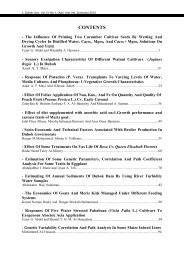Create successful ePaper yourself
Turn your PDF publications into a flip-book with our unique Google optimized e-Paper software.
J. Duhok Univ., Vol.14, No.1 (Pure and Eng. Sciences), Pp 30-38, 2011<br />
oxidative damage. The reactive species<br />
scavenged by vitamin C include superoxide,<br />
aqueous peroxyl radicals, singlet oxygen, ozone,<br />
peroxynitrite, nitrogen dioxide, and<br />
hypochlorous acid (Halliwell,1996). Attri et al.,<br />
(2003) concluded that concomitant<br />
administration of vitamin C ameliorates HTN,<br />
and normalizes NO levels. Compared with<br />
control group, blood Pb level was decreased<br />
significantly after given vitamin C, vitamin E or<br />
combination of vitamin C and E. The<br />
concentrations of superoxide dismutase, NO and<br />
NOS were significantly higher in vitamin C<br />
and/or E groups than those in control group<br />
(Li et al., 2008)<br />
The effects of co-administration of melatonin<br />
with vitamin C and E on SBP are not examined<br />
yet. Therefore, the aim of the present study was<br />
to investigate the effects of long-term<br />
administration of melatonin, vitamin C, vitamin<br />
E and in combinations, on BP, serum NO<br />
,calcium ions ,electrolytes and body weight gain<br />
or loss in lead-induced hypertensive rats.<br />
MATERIALS AND METHODS<br />
Animals and housing<br />
Fifty four adult female albino rats (Rattus<br />
norvegicus) were used in this study. All rats<br />
were weighing about (240 - 280 gm) and (7-9)<br />
weeks of age at the time when the experiment<br />
started. Animals were housed in plastic cages<br />
bedded with wooden chips. They were housed<br />
under standard laboratory conditions, 12:12<br />
light/dark photoperiod at 22 ± 2 ºC. The<br />
animals were given standard rat pellets and<br />
tap water ad libitum.<br />
Experimental Design<br />
This experiment was planed to study the<br />
effects of melatonin, vitamin E ,vitamin C and<br />
their combinations on SBP, heart rate, serum<br />
NO, sodium, potassium , calcium and body<br />
weight in rats treated with lead acetate. The<br />
experimental rats were divided to nine groups,<br />
each with six individuals and the treatments<br />
were continued for 10 weeks as the following:<br />
Group 1: Control. The rats were given standard<br />
rat chow and tap water ad libitum.<br />
Group 2: Sodium acetate . The rats were given<br />
standard rat chow and sodium acetate at dose<br />
(0.1mg/L drinking water).<br />
Group 3: Lead acetate (Pb). The rats were given<br />
standard rat chow and lead acetate at dose<br />
(0.1mg/L drinking water).<br />
Group 4: Pb + Melatonin. The rats were<br />
supplied with standard rat chow with melatonin<br />
(60 mg/kg diet) and Pb<br />
Group 5: Pb +Vitamin E. The rats were supplied<br />
with standard rat chow with vitamin E (1000<br />
I.U/kg diet) and Pb<br />
Group 6: Pb +Vitamin C. The rats were given<br />
standard rat chow with Pb and vitamin C at dose<br />
(1mg/L drinking water).<br />
Group 7: Pb + Melatonin + Vitamin E. The rats<br />
were supplied with standard rat chow with<br />
melatonin , vitamin E and Pb.<br />
Group 8: Pb + Melatonin +Vitamin C. The rats<br />
were supplied with standard rat chow with<br />
melatonin , vitamin C and Pb.<br />
Group 9: Pb +Vitamin E+ Vitamin C. The rats<br />
were supplied with standard rat chow with<br />
vitamin E , vitamin and Pb.<br />
Collection of blood samples<br />
At the end of the experiment, the rats were<br />
anesthetized with ketamine hydrochloride (50<br />
mg/kg). Blood samples were taken by cardiac<br />
puncture into chilled tubes and centrifuged at<br />
3000 rpm for 20 minutes; then sera were stored<br />
at -85C 0 until assay.<br />
Blood pressure and heart rate measurements<br />
Measurements of SBP and heart rate were<br />
obtained each two weeks by the tail-cuff method<br />
in all groups using power Lab (AD Instruments,<br />
power lab 2/25). During the week before<br />
treatment the rats were trained to become<br />
accustomed to the blood pressure measurements.<br />
Rats were placed in a restraining chamber and<br />
warmed to an ambient temperature of<br />
approximately 37C o , typically taking about 10-<br />
15 minute after that occluding cuffs and<br />
pneumatic pulse transducers were placed on the<br />
rats' tails. Six readings were taken for each rat,<br />
the highest, lowest and any associated with<br />
excess noise or animal movement were<br />
discarded. The average was taken of the<br />
remaining readings to generate a value for a<br />
given rat for that week.<br />
BIOCHEMICAL DETERMINATION<br />
Determination of serum sodium, potassium<br />
and calcium ion concentrations<br />
Serum Na + and K + ion concentrations were<br />
determined by using flame photometer<br />
(Galenkamp Flame Analyzer, Germany). Serum<br />
calcium was determined by spectrophotometer<br />
calcium kit Serum total nitric oxide<br />
measurement Serum total NO was<br />
determined by NO non –enzymatic assay kit<br />
(US Biological, USA)<br />
03



